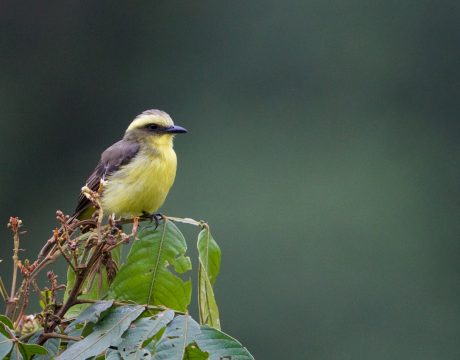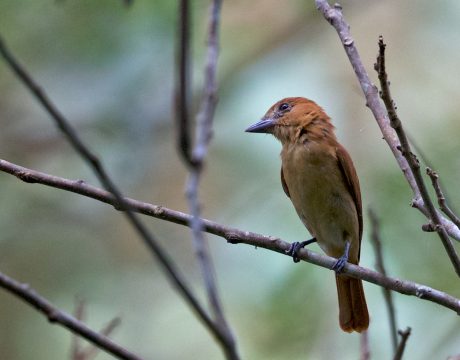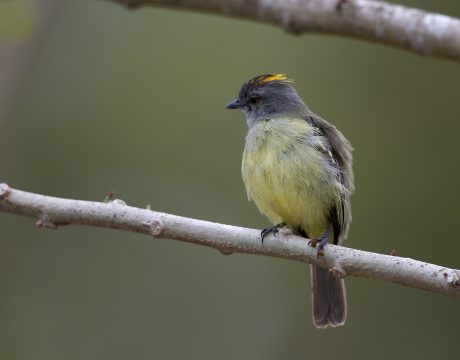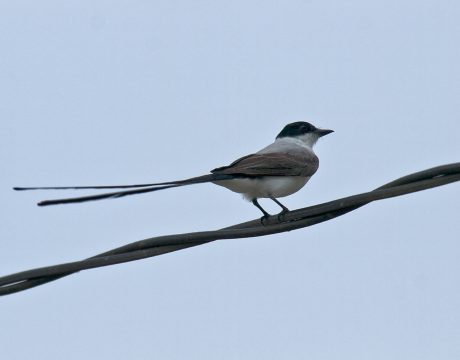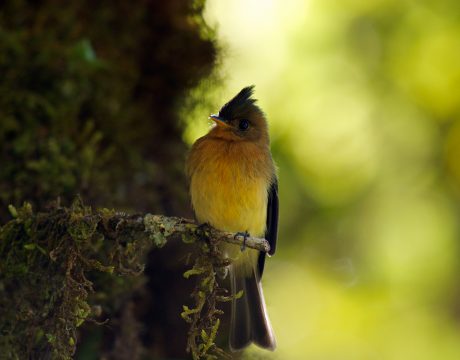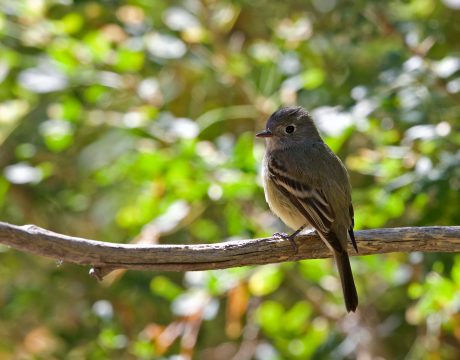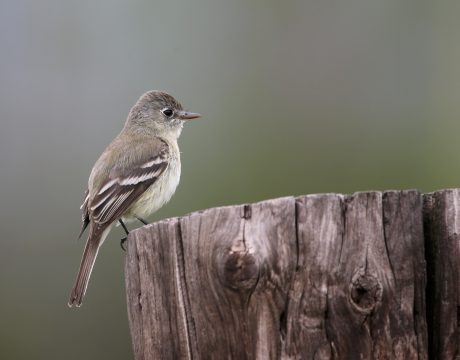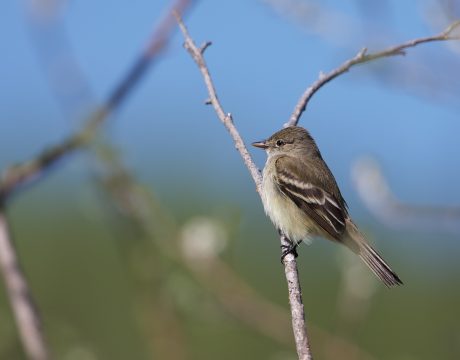Return of Bird of the Week: Brewer’s Blackbird
We’ll take a reprieve break from the unending photos of flycatchers for a bit and celebrate the imminence of spring with a blackbird, specifically the Brewer’s Blackbird. Brewer’s Blackbirds get no respect. They don’t have the flashy colors like their cousins, and the are so common in season that we take them for granted. But the males, in the right light, have the beautiful green iridescence and that attention-grabbing yellow eye. WC doesn’t usually do much high key bird photo work; it seems to distract from the bird as the subject. But this shot of a male doing a courtship display…
Return of Bird of the Week: Lemon-browed Flycatcher
Another of the Western Hemisphere’s hundreds of flycatchers, the Lemon-browed Flycatcher is a very handsome bird. It’s also a bit of a specialist, restricted to a fairly narrow zone, between 800 and 1,950 meters elevation on the east slope of the Andes. Lemon-browed Flycatchers inhabit edges and clearings in humid subtropical forest, where they frequently sit on bare twigs and treetops. Like related flycatchers, they sally out to catch insects in flight, often returning to the same perch. They are quite vocal, giving a loud, stuttering “d’d’d’d’eeeeer” that can be heard at a distance. Although the Lemon-browed Flycatcher is widespread,…
Return of Bird of the Week: One-colored Becard
Among the hundreds of kinds of flycatchers, there is a genus called Becards. They occurs throughout the Neotropics, although one species, the Rose-throated Becard, occurs as far north as the far southern United States. Altogether there are 17 species of Becards. Sometimes WC suspects that ornithologists ran out of imaginative names for birds, and the poor One-colored Becard would be Exhibit A. Seriously, this is handsome bird; “one-colored” is the best ornithology can do? Becards as a group are large-headed birds, and the One-colored is no exception. Males are predominantly blackish, albeit becoming steadily paler over the underparts, and females…
Return of Bird of the Week: Yellow-crowned Tyrannulet
WC wasn’t exaggerating when he said there were dozens of flycatchers; if anything, it’s an understatement. Here’s a species WC was lucky enough to photograph in Panama recently, the Yellow-crowned Tyrannulet. This is a smaller flycatcher, about 4.5 inches long, with a stubby bill and grayish-yellow breast. The wing shows to buffy-yellow wing bars, visible in the second photo. And, of course, the yellow crown that gives the species its name. That’s not always visible, and WC was happy to get a photo that shows it. What’s a bit unusual about this bird is that it doesn’t show the whitish-gray…
Return of Bird of the Week: Fork-tailed Flycatcher
This is a pretty wretched photo; WC includes it only because it’s the best image WC has of this distant cousin to last week’s Scissor-tailed Flycatcher, the Fork-tailed Flycatcher. It’s a vagrant species in the United States, but fairly common in Mexico and Central America, and much of South America. The tail is even longer than the Scissor-tailed’s. It’s difficult to confuse the two species: the Scissor-tailed has a white head; the Fork-tailed has a black cap and lacks the buffy wash on the sides of the body. This is a bird of open habitats, including forest edges, secondary vegetation, savannas,…
Return of Bird of the Week: Tufted Flycatcher
The Tufted Flycatcher is another beautiful, elegant bug-eating bird. It’s fairly common in Mexico and Central America, ranging into northern Columbia and occasionally into Texas and Arizona. WC wouldn’t usually post a strongly backlit image like this, but this male was guarding (or distracting possible predators) from his mate and their nest. As you can see, the nest itself is almost perfectly camouflaged against the mossy tree trunk. This pretty little lady decided WC wasn’t a threat and hunkered down on her nest. Classification of Tufted Flycatchers is an ornithological train wreck. Depending on who you talk to and what…
Return of Bird of the Week: Long-tailed Silky Flycatcher
Missed a post. Sorry about that. WC has by no means exhausted the genus Empidonax, but he suspects he has long since exhausted his readers’ patience with little brown jobs that look pretty much the same. We’ll stay with flycatchers, but shift to some more visually interesting species for a while. Late on one afternoon, birding along a dirt road in the cloud forests in Costa Rica, almost by accident, WC found his first Long-tailed Silky Flycatcher. What followed was pretty maddening. My Olympus E-5 DSLR camera simply could not acquire a sharp focus. It turns out that all autofocus systems have…
Return of Bird of the Week: Cordilleran Flycatcher
WC warned readers that flycatchers of the genus Empidonax were difficult to tell apart. And perhaps the worst case is the Cordilleran Flycatcher, which is pretty much indistinguishable from its cousin, the Pacific Slope Flycatcher. WC doesn’t have any really good images of this species – they are all backlit. But here’s a side-by-side to illustrate the problem. Good luck telling them apart. Which is why everyone but Peter Pyledepends on song and geography. These photos are both from September, so WC relied on geography. Flycatchers don’t sing that much in the autumn. Cordilleran Flycatchers are primarily found in the Rocky Mountains,…
Return of Bird of the Week: Pacific Slope Flycatcher
Once upon a time there was a bird species called a Western Flycatcher. Another member of the Empidonaxgenus. But ornithologists decided in 1989 that what had been called Western Flycatchers were actually two different species, distinguished by song and geography. Not by appearance. Birds of North America, the on-line databases of North American birds, says (paywall): In the hand, Pacific slope and Cordilleran flycatchers may be identified with extreme caution; many individuals must be left unidentified. Sex and age differences exist within each species. That’s right, a difficult to identify bird species was split into two almost impossible to distinguish species. To…
Return of Bird of the Week: Alder Flycatcher
Identification of flycatchers can be hard. Really hard. But now that we’re warmed up with all those yellow, black and white flycatchers, let’s continue our examination of some reallyhard birds: the infamous Empidonaxgenus, the “Emps.” Because after you’ve done Emps, nothing will seem as hard. Last week we looked at the Hammond’s Flycatcher. This week we’ll have a look at the Alder Flycatcher. This species has an impressive migration: it winters in South America, mostly in Brazil but as far south as Argentina. It’s a later arrival in the boreal forest, where it joins other Emps to torment birders. Here’s the…






